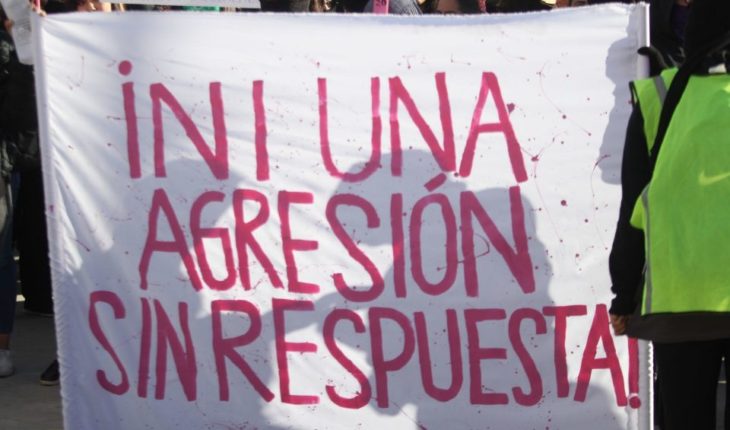Ingrid Escamilla was murdered at the hands of his partner, Erick Francisco “N”. The case was made clear of the fact by authorities of details of his death and explicit photographs of his body, which were later published by the media.
Leaks of information and images of victims by local authorities is a recurring practice, notes Veronica Berber, a member lawyer of the Feminist Circle of Legal Analysis.
This was even grounds for the Commission on Human Rights of Mexico City (CDHDM) to issue recommendation 4/2017 to the then Attorney General’s Office and the High Court of Justice – both of Mexico City – for the case of multi-homicide in the Narvarte colony, which occurred in 2015.
Read: At 25, Ingrid enjoyed her pets and traveling, until she was killed by her partner
The recommendation to investigate the officials responsible for the leaks of the Narvarte case was not fulfilled, so this practice has continued in the Public Prosecutor’s Office, said Berber, who is also a teacher at the Instituto Tecnológico Autónomo de México (ITAM).
According to the lawyer, the leak ingesting Ingrid’s photograph damaged her honor, her dignity and her image, and also affected her family.
Following criticism of the leak of the photograph, as well as a video in which the man accused of murdering her confesses the crime, the Mexican City Undersecretary of Human Rights (SSDDHH) ordered the reproduction of these materials and called not to re-victimize it for profit and morbid purposes.
Through social media, the SSDHH called these leaks “expressions of hatred and indolence issued even after their death,” and acknowledged the authorities’ obligation to investigate them.
“Ingrid’s body image leaks are deeply outrageous acts that attack the victim and society at large. These acts must also be investigated and responsibilities delineated,” he said.
For its part, the Attorney General’s Office of Mexico City (FGJCDMX) reported that it is already investigating six officials who attended the scene and possibly misused the images they took during the first surveys and the lifting of Ingrid’s body.
You may be interested: Incompetence, misogyny and political management affect the registration of femicides in the states, alert experts
Veronica Berber explained that the leak in in the Ingrid case could not only proceed to the Internal Supervisory Body (ICO) of the Public Prosecutor’s Office – to which the family would have to file a complaint in order to investigate who are the officials responsible for the release of the photograph – but also through the criminal proceedings.
In the case of the complaint to the Public Prosecutor’s Office for the violation of the rights to dignity and honor of Ingrid for the reproduction in media of the photograph, and those that result, “it can be made by any person or collective from what was made public, because it is only to make knowledge of the facts to the Public Prosecutor’s Office, which are possibly criminal”.
1)Demand for moral damage to media
2)Complaint to the public prosecutor’s office as its staff did not adequately safeguard the information
3)Complaint to the @CDHDF for the Mass that the previous point
— Feminist Circle of Legal Analysis (@CirculoAnalisis) February 11, 2020
Photographing victims is forbidden
According to lawyer Karla Michel Salas, taking or videorecording the body of any victim is prohibited, as indicated in the Protocol for the Investigation of femicide Crime, in force in Mexico City since 2011.
“It is very worrying this practice that the Public Prosecutor’s Office has, formerly the Attorney General’s Office, particularly because of what it does to the Public Prosecutor’s Offices, police and experts who are at the scene and who improperly photograph the body and subsequently sell the photographs,” she explained.
The strategic femicide case litigation specialist accused that another recurring practice by the investigative staff is to allow access to the scene of the facts to people outside security institutions, such as journalists, who are allowed to take images in exchange for money or favors.
“It is clearly an administrative responsibility, there is an express prohibition, on the other hand there is already a protocol that was being worked on on the issue of leaks, because it has been a recurring recommendation, it has been the subject of various precautionary measures that the local human rights commission has launched to FGJCDMX. It’s not a new subject,” he said.
In an interview with Animal Político, the lawyer detailed that this administrative responsibility can result in criminal liability, “but it depends, we need to investigate and know if the authorities are doing it in exchange for money, in exchange for favors, we do not know, because it is also clear the means to which they filter them and what kind of information they give them. I think it’s important to put it on the table.”
Read more: Prosecutors investigate only 1 in 5 women’s murders as femicide
Journalism should not naturalize violence
According to Lucía Lagunes, Director of Communication and Information of Women, A.C. (CIMAC), the mass reproduction of images of the bodies of victims of femicide, contributes to the normalization of violence against women and sends the message that any girl or adult can be as follows.
“The pedagogy that this type of image is doing reaffirms in men the social mandate of harmful, violent masculinity that attacks women, and on the side of girls sends the message that they may be the next victims, and we need to break back and forth,” she said.
For her, there are currently two types of journalism on the subject of violence against women, on the one hand, there are the media “which unfortunately years ago grew convinced that blood sells, that the morbid is news and that they educated the population in this logic and that they have built chains of corruption in order to maintain sensationalism about violence and pain of others”.
On the other hand, “there are the media that have heard the public’s demand to say ‘we want to be treated with respect, women, victims’ and that it has really questioned whether filtering images or placing these heartbreaking images is journalism,” he said.
However, he asserted, all media and journalists “today as we are never called to an ethics of all, an ethics that sanction and that eliminates these misogynistic, sexist, old, old practices that have done so much harm to humanity.”
“It cannot be justified that the naturalization of violence against women continues to be nurtured and aggressors as sick, possessed, disrupted continued to be justified,” he concluded.
The National Commission to Prevent and Eradicate Violence against Women (Conavim) reported on how various media outlets disseminated the information and image of femicide, as they re-victimized Ingrid.
He asked the capital authorities to investigate who leaked the information to the media.
To the media, Conavim recommended training and professionalizing its workers to understand inclusive language and what the General Law on Women’s Access to a Life Free from Violence states.
We share with you the Commission’s statement on how the media dealt with the holders, information and images of Ingrid’s body. pic.twitter.com/CugOe6UqBF
— CONAVIM_MX (@CONAVIM_MX) February 12, 2020
What we do in Animal Político requires professional journalists, teamwork, dialogue with readers and something very important: independence. You can help us keep going. Be part of the team.
Subscribe to Animal Politician, receive benefits and support free journalism.#YoSoyAnimal





